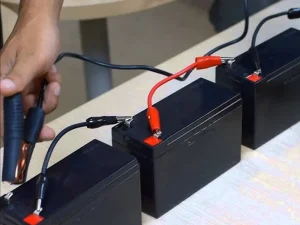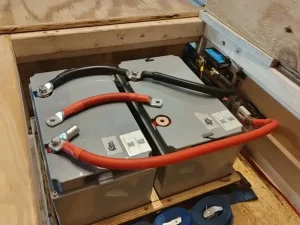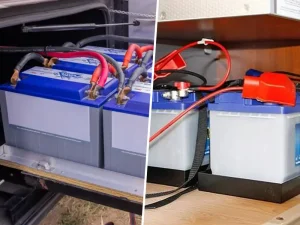Connecting multiple batteries to the system can help you reach your device’s required output level. However, connecting them requires some technical understanding. Should it be a series, parallel, or series-parallel connection? This choice of connection impacts performance, runtime, and power output. Batteries can be set up in series or parallel for different resulting outputs. Each setup has its benefits. Choosing the right setup will give you a high voltage, runtime, or both. Also, charging efficiency and overall battery life are affected. What is the better connection method between batteries in series VS parallel or series-parallel? The following discussion explains series and parallel battery connections while determining their advantages and disadvantages.
How to Connect Batteries in Series?
When you join batteries through a serial connection, the voltage output increases. The batteries maintain their original capacity levels. The setup links battery terminals so their negative and positive ends function jointly. The joined connection provides additional power output beyond what a single battery can generate.

Series connections add voltages but do not change amp-hour (AH) capacity. Linking two 4.5 AH capacity 6-volt batteries in series will generate 12 volts (6V + 6V) while the 4.5 AH capacity remains intact. When two 12-volt batteries are linked in series, they generate a collective 24-volt system. So, here, the amp-hour (AH) rating maintains its original value for every battery in the series connection.
The two batteries connected in series must have the same voltage and amp-hour ratings. A difference in voltage and amp-hour ratings can damage the batteries.
The following procedure shows how to connect batteries in series:
- You should connect the negative terminal of your first battery to the positive terminal of your second battery.
- Keep connecting the batteries. Link negative to positive. Connect the batteries in a line by repeating this process.
- Start by linking the positive terminal of your device to the first battery’s positive terminal.
- Link your device’s negative terminal to the last battery’s negative terminal in the series.
How to Connect Batteries in Parallel?
The parallel battery connection expands your power capacity without altering the voltage level. Using this configuration extends the runtime of your devices or applications.

Connecting batteries in a parallel configuration results in their amp-hour (AH) capacities combining. However, the voltage remains unchanged. Two 12V 30Ah batteries linked in parallel configuration lead to 60 amp-hours.
The batteries in parallel configurations must share identical voltage values and capacity ratings. Here is how to connect batteries in parallel:
- Link all positive terminals together with welding cables. Connect the positive terminal of the first battery directly to the positive terminal of the second battery.
- Connect all negative terminals together with separate cables. Join the negative terminal of the first battery to the negative terminal of the second battery.
- For extra batteries, connect all positives to positives and all negatives to negatives.
- Connect your device by attaching its positive wire to any battery’s positive terminal during setup.
- Connect your device’s negative wire to the negative terminal of any battery in the parallel bank to complete the circuit.
Comparing Batteries in Series VS Parallel Connections: Which One is Better?
The two primary methods to combine batteries are series and parallel arrangements. So, when comparing the batteries in series VS parallel, which works best? The choice depends solely on your power application needs. Battery arrangement directly affects both voltage strength and energy reserve capabilities as well as discharge speed. Now, let’s see the advantages and disadvantages of both the connection.
Advantages of Series Connections
Series connections boost voltage by adding up each battery’s power. This helps run devices that need more voltage to work well. Your electric vehicles and backup power systems work better with steady power from series setups. Wiring is easier, too. You’ll spend less money since you need fewer batteries to get higher voltage. Additionally, the lower current flow enables the use of thinner wires. This saves you money on materials. When a battery starts to fail, you can spot the problem faster in a series setup.
Disadvantages of Series Connections
Series connections have some big problems. If one battery dies, your whole system stops working. This is bad for important power needs. Batteries often charge and discharge unevenly. Weaker batteries get damaged faster, and this hurts your whole system.
You’ll need extra equipment like battery equalizers to keep charging balanced. This makes your system more complex. It also makes setup and repairs harder. Batteries in series wear out at different speeds. This means you’ll replace batteries more often. Your total power capacity stays limited to what one battery can hold.
Advantages of Parallel Connections
Parallel connections boost the total power output. This helps run devices that need a lot of power. If one battery stops working, the other batteries keep going. Your system stays on, which is great for important tasks.
All batteries get the same voltage when connected this way. The risk of charging problems becomes significantly reduced by this method. The system allows you to connect additional batteries to boost your power supply. You don’t have to replace all components right away. Using smaller batteries lets you replace the bulkier, heavier battery models. This makes setup much easier.
Better portability results from small battery dimensions because they are lighter while being easier to manage. Installation of these devices does not need additional equipment since they can be easily set up.
Disadvantages of Parallel Connections
Parallel setups have some problems too. If one battery gets too hot, it can make other batteries heat up. This might damage all your batteries at once. You need thicker cables for parallel connections. These cost more money and take up more space.
Even matching batteries can charge and discharge at different rates. This happens because of tiny differences inside each battery. Over time, this hurts how well your system works. Parallel setups pull more current. This puts more stress on your cables and connectors. You’ll also see more voltage drop in parallel systems. This means less power gets to where you need it.
Choosing the Right Batteries for Your Setup
No matter if you go for a series or parallel connection, picking the right batteries is crucial for safety and performance. Lithium-ion batteries are a great option—they’re powerful, last long, and come with safety features. At Legend Batteries, our lithium-ion battery packs work perfectly in both setups. They’re ideal for things like electric vehicles, drones, and energy storage.
Batteries in Series VS Parallel… or Series-Parallel?

Now that you have read about battery connection in series and parallel, there is one more connection option. It’s called a series-parallel connection.
A series-parallel connection means you first connect some batteries in series. Then, you connect these series sets in parallel. This gives you the benefits of both types of batteries in parallel and series connection. The series setup delivers higher voltage while the parallel section provides increased capacity.
A 12V 300Ah system will be achieved when you connect six batteries of 6V 100Ah in a parallel setup. Starting with two connected batteries in series produces a 12V output. Then you make three of these series pairs. Finally, you connect all three pairs in parallel to get 300Ah total capacity.
To make a series-parallel connection:
Start by connecting the batteries in series through positive and negative terminal connections.
Make several of these series of sets.
Connect all the series sets in parallel. Join all the positive terminals together, and also join all the negative terminals together.
This setup works well when you need both higher voltage and more runtime. This connection type serves RVs, boats, and off-grid power systems.
It is safe to connect multiple wires to specific terminals. This is normal and needed to make these connections work right.
When wiring batteries in parallel and series at once, use matching types, equal voltages, and capacities. Using batteries of different types results in charging problems and reduces overall battery life.
FAQs
Does connecting batteries in parallel increase amp-hours?
Yes. Parallel connections add up the amp-hours of all batteries. The voltage stays the same. Two 12V 100Ah batteries linked in parallel configuration will produce a 12V system with 200Ah capacity. The battery arrangement extends your power supply duration by two times. Your devices operate without needing battery recharges for an extended period.
What happens when you put two 12-volt batteries in series?
Two series-connected 12-volt batteries generate an output of 24 volts. The amp-hours stay the same as one battery. Your voltage goes up, but runtime doesn’t change. This higher voltage helps run devices that need more power to work properly. Many RVs and boats use this setup to power their systems.
Do batteries last longer in series or parallel?
Batteries in parallel last longer between charges. This happens because parallel adds amp-hours. More amp-hours mean more runtime. For example, two 50Ah batteries in parallel give you 100Ah total. The series might work more efficiently, but parallel gives you more total running time.
Can you put LiFePO4 batteries in series?
Yes, you can. But first, check your battery manual. The series combination of LiFePO4 batteries maintains proper functional output. Properly connecting four 12V LiFePO4 batteries leads to a 48V output. The battery packs come with essential instructions that users need to follow. Reading the instructions allows you to prevent system damage.
Is series or parallel more powerful?
The power output of parallel circuits exceeds that of series circuits when operating at identical voltages. This happens because more current flows in parallel. But “more powerful” depends on what you need. The series gives a higher voltage. Parallel gives more current and capacity. Pick the one that fits your needs best.
Which is safer, series or parallel?
Both have safety issues. Series produces higher voltage, which can be risky if not handled correctly. Parallels can produce very high currents if something goes wrong, which might cause overheating. The main safety concern is proper setup, not which type you choose. Always follow safety rules when working with batteries.
